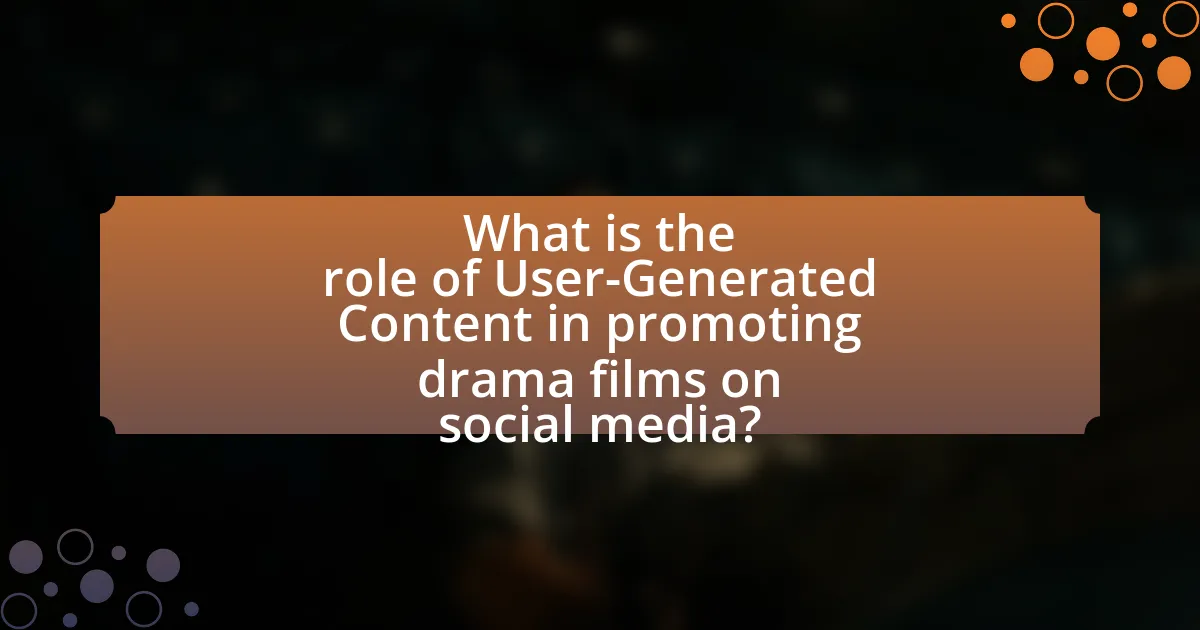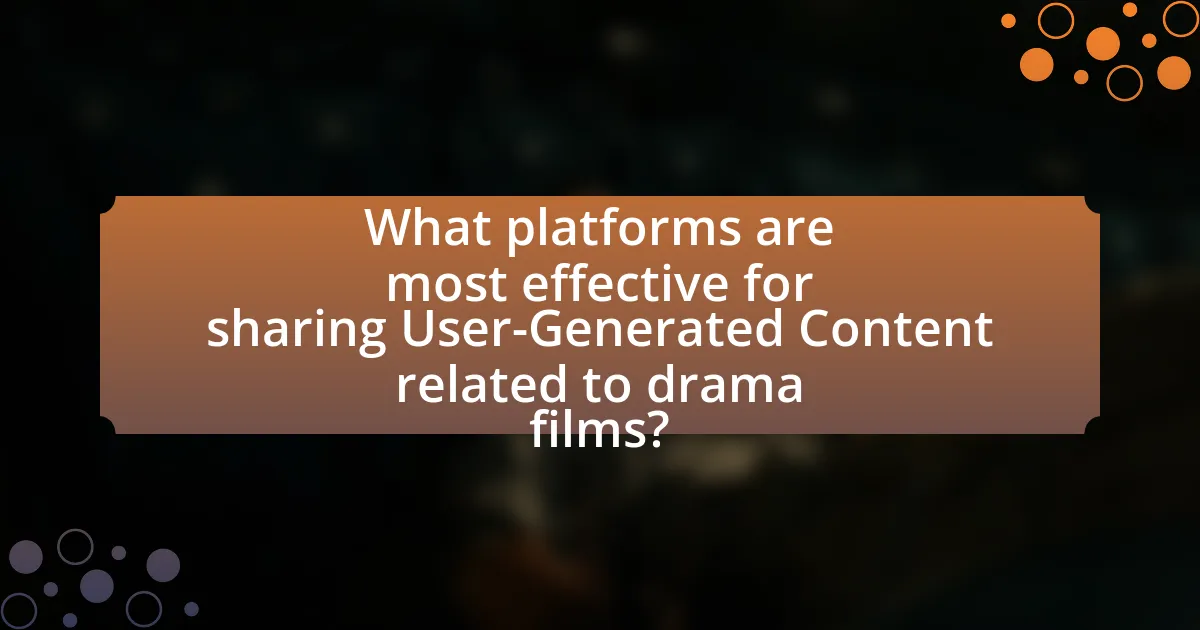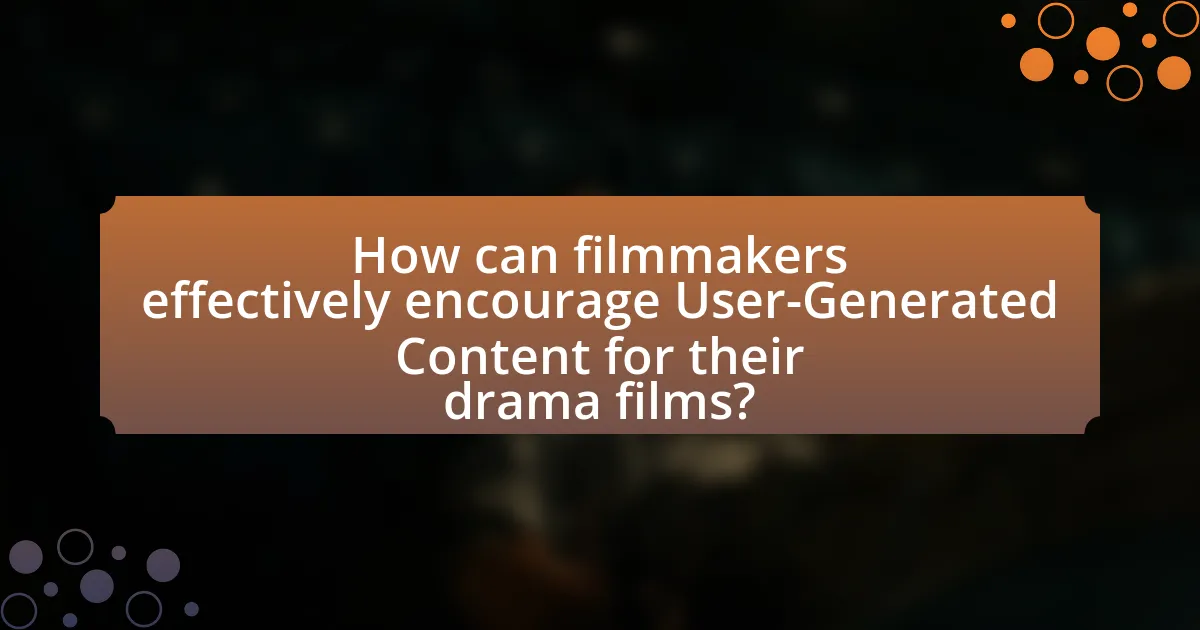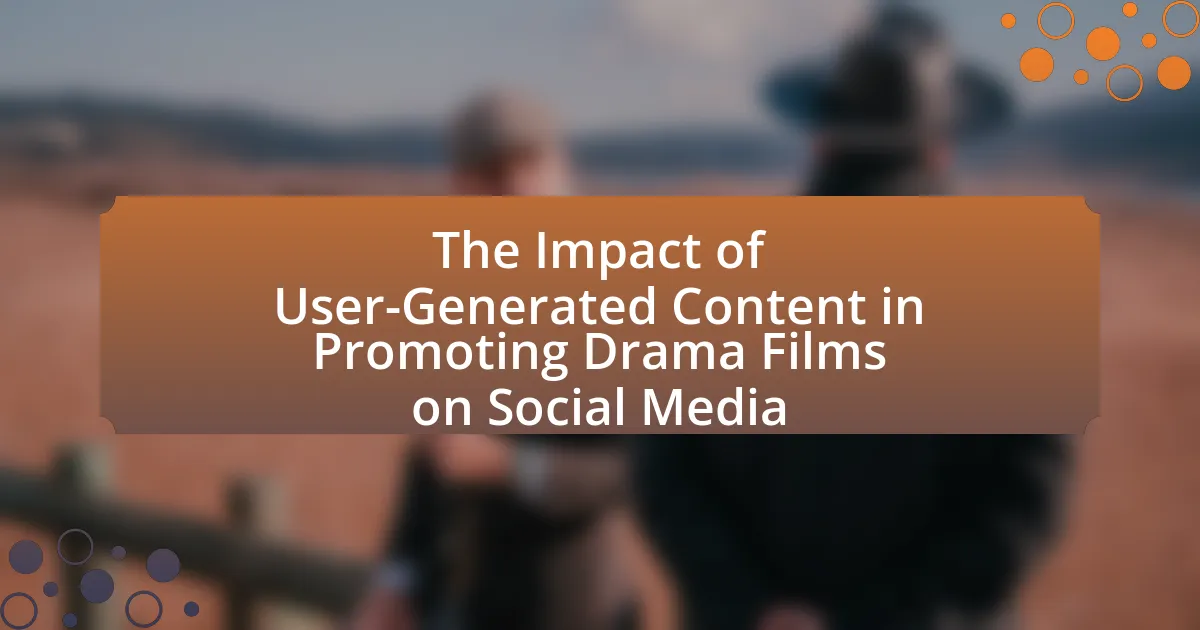User-Generated Content (UGC) plays a vital role in promoting drama films on social media by enhancing audience engagement and fostering community. The article explores how UGC, including reviews, fan art, and social media posts, influences audience perception and purchasing decisions, with studies indicating that 79% of consumers trust UGC as much as personal recommendations. It discusses effective types of UGC for film promotion, compares UGC to traditional marketing methods, and highlights the importance of platforms like Instagram and TikTok in amplifying visibility. Additionally, the article addresses challenges filmmakers face with UGC, strategies for encouraging audience participation, and future trends in UGC that will shape the relationship between filmmakers and audiences.

What is the role of User-Generated Content in promoting drama films on social media?
User-Generated Content (UGC) plays a crucial role in promoting drama films on social media by enhancing audience engagement and building community around the film. UGC, such as reviews, fan art, and social media posts, fosters a sense of authenticity and relatability that traditional marketing often lacks. According to a study by the Digital Marketing Institute, 79% of people say user-generated content highly impacts their purchasing decisions, indicating that UGC can significantly influence viewers’ interest in drama films. Furthermore, platforms like Instagram and TikTok allow users to share their interpretations and experiences related to the film, creating organic buzz and increasing visibility. This grassroots promotion can lead to higher ticket sales and a more dedicated fan base, demonstrating the effectiveness of UGC in the film marketing landscape.
How does User-Generated Content influence audience perception of drama films?
User-Generated Content (UGC) significantly influences audience perception of drama films by shaping opinions and creating a sense of community among viewers. UGC, such as reviews, social media posts, and fan art, provides authentic insights that can enhance or diminish the perceived quality of a film. For instance, a study by the University of Southern California found that 79% of consumers trust online reviews as much as personal recommendations, indicating that UGC can sway audience expectations and interest in drama films. Additionally, UGC fosters engagement and discussion, allowing audiences to connect over shared experiences and interpretations, which can further solidify their emotional investment in the film.
What types of User-Generated Content are most effective for drama film promotion?
The most effective types of User-Generated Content (UGC) for drama film promotion include fan art, reviews, and behind-the-scenes footage. Fan art engages the audience creatively, allowing them to express their connection to the film, which can lead to increased sharing and visibility. Reviews, particularly video testimonials or written posts, provide authentic opinions that can influence potential viewers, as studies show that 79% of consumers trust online reviews as much as personal recommendations. Behind-the-scenes footage offers an insider perspective that can intrigue audiences, fostering a deeper emotional connection to the film. These forms of UGC not only enhance engagement but also leverage the trust and creativity of the audience to amplify promotional efforts.
How does User-Generated Content compare to traditional marketing methods for drama films?
User-Generated Content (UGC) is generally more effective than traditional marketing methods for drama films due to its authenticity and engagement potential. UGC fosters a sense of community and trust among audiences, as consumers often perceive content created by their peers as more relatable and credible compared to polished advertisements. According to a study by Nielsen, 92% of consumers trust recommendations from friends and family over any other form of advertising, highlighting the power of UGC in influencing viewer decisions. Additionally, UGC can lead to increased social media interaction, with platforms like Instagram and TikTok showcasing user-created trailers or reviews that can go viral, further amplifying a film’s reach. In contrast, traditional marketing methods, such as television ads or billboards, often lack this level of personal connection and engagement, making UGC a more impactful strategy for promoting drama films.
Why is User-Generated Content important for drama film marketing?
User-Generated Content (UGC) is important for drama film marketing because it enhances audience engagement and builds authenticity. UGC allows fans to share their interpretations and emotional connections to the film, creating a sense of community and increasing word-of-mouth promotion. According to a study by Nielsen, 92% of consumers trust organic, user-generated content more than traditional advertising, which underscores its effectiveness in influencing potential viewers. This trust translates into higher engagement rates and can significantly boost a film’s visibility on social media platforms, making UGC a vital component of successful drama film marketing strategies.
What psychological factors drive engagement with User-Generated Content?
Psychological factors driving engagement with User-Generated Content (UGC) include social validation, identity expression, and emotional connection. Social validation occurs when individuals seek approval from peers, leading them to engage with content that resonates with their social circles. Identity expression allows users to showcase their beliefs and preferences through UGC, fostering a sense of belonging. Emotional connection is significant as content that evokes strong feelings, such as nostalgia or empathy, encourages sharing and interaction. Research indicates that 79% of consumers say user-generated content highly impacts their purchasing decisions, highlighting the effectiveness of these psychological factors in driving engagement.
How does User-Generated Content enhance community building among drama film fans?
User-Generated Content (UGC) enhances community building among drama film fans by fostering engagement and creating shared experiences. When fans create and share their own content, such as reviews, fan art, or discussion posts, it encourages interaction and dialogue within the community. This interaction strengthens connections among fans, as they find common ground in their appreciation for specific films or themes. Research indicates that communities with high levels of UGC see increased participation rates, as fans feel more invested and valued when their contributions are recognized. For instance, platforms like Reddit and Instagram have shown that drama film fan communities thrive on user-generated discussions and content, leading to a more vibrant and cohesive community.

What platforms are most effective for sharing User-Generated Content related to drama films?
The most effective platforms for sharing User-Generated Content related to drama films are Instagram, TikTok, and YouTube. Instagram allows users to share visually appealing content, such as images and short videos, which can effectively capture the emotional essence of drama films. TikTok’s short-form video format encourages creative expression and engagement, making it ideal for sharing clips, reviews, and fan interpretations of drama films. YouTube serves as a comprehensive platform for longer content, including reviews, discussions, and fan-made trailers, which can reach a wide audience and foster community engagement around drama films. These platforms have been shown to enhance visibility and engagement, with Instagram boasting over 1 billion monthly active users, TikTok reaching 1 billion downloads, and YouTube being the second most visited website globally, thus validating their effectiveness in promoting User-Generated Content for drama films.
How do different social media platforms impact the visibility of User-Generated Content?
Different social media platforms significantly impact the visibility of User-Generated Content (UGC) through their unique algorithms, audience demographics, and engagement features. For instance, platforms like Instagram and TikTok prioritize visual content, enhancing the reach of UGC through features like hashtags and trending challenges, which can lead to viral exposure. In contrast, Facebook’s algorithm favors content that generates meaningful interactions, often limiting the visibility of UGC unless it receives substantial engagement from users. Additionally, Twitter’s real-time nature allows UGC to gain visibility quickly during trending events or discussions, but its lifespan is shorter compared to platforms that support evergreen content. Research indicates that UGC on Instagram can achieve engagement rates up to 4.5% compared to 0.1% for brand-generated content, highlighting the effectiveness of UGC in capturing audience attention. Thus, the choice of platform plays a crucial role in determining how widely UGC is seen and interacted with by users.
What features of platforms like Instagram and TikTok facilitate User-Generated Content sharing?
Platforms like Instagram and TikTok facilitate User-Generated Content (UGC) sharing through features such as easy-to-use editing tools, hashtags, and interactive elements like polls and challenges. Instagram provides a range of filters, stickers, and editing options that allow users to create visually appealing content quickly, while TikTok offers a vast library of music and sound effects that enhance creativity. Both platforms utilize hashtags to categorize content, making it easier for users to discover and engage with UGC related to specific themes or trends. Additionally, TikTok’s challenges encourage users to participate and create content around a common idea, further promoting sharing and engagement. These features collectively enhance the visibility and accessibility of UGC, driving its proliferation on social media.
How can drama films leverage platform-specific trends to enhance User-Generated Content engagement?
Drama films can leverage platform-specific trends by tailoring their marketing strategies to align with the unique features and user behaviors of each social media platform. For instance, on TikTok, drama films can create short, engaging clips that highlight emotional moments or pivotal scenes, encouraging users to recreate or respond to these clips, thus generating user-generated content. Research indicates that TikTok’s algorithm favors content that encourages interaction, leading to increased visibility and engagement for the film.
On Instagram, drama films can utilize visually appealing stills or behind-the-scenes content to inspire fans to share their interpretations or fan art, capitalizing on the platform’s emphasis on aesthetics and community. A study by the Pew Research Center shows that 71% of Instagram users engage with brands, indicating a strong potential for user-generated content when films actively participate in trends like challenges or hashtags.
By analyzing and adapting to these platform-specific trends, drama films can effectively enhance user-generated content engagement, driving both visibility and audience connection.
What challenges do filmmakers face when utilizing User-Generated Content?
Filmmakers face several challenges when utilizing User-Generated Content (UGC), primarily concerning quality control, copyright issues, and audience engagement. Quality control is a significant challenge, as UGC can vary widely in production value and relevance, potentially undermining the film’s professional image. Copyright issues arise when filmmakers must navigate the legal complexities of using content created by others, which can lead to disputes or the need for permissions that complicate the production process. Additionally, engaging audiences effectively with UGC can be difficult, as filmmakers must ensure that the content resonates with their target demographic while maintaining a cohesive narrative that aligns with the film’s themes. These challenges highlight the need for careful curation and strategic planning when integrating UGC into film promotion.
How can filmmakers address issues of content quality and authenticity?
Filmmakers can address issues of content quality and authenticity by implementing rigorous vetting processes for user-generated content and collaborating with credible creators. By establishing clear guidelines and standards for submissions, filmmakers can ensure that the content aligns with the film’s themes and quality expectations. Research indicates that user-generated content can enhance audience engagement, but authenticity is crucial; for instance, a study by the Pew Research Center found that 64% of social media users value authenticity in content. Therefore, filmmakers should prioritize partnerships with influencers and creators who have a proven track record of producing high-quality, authentic content that resonates with their audience.
What legal considerations should filmmakers keep in mind regarding User-Generated Content?
Filmmakers must consider copyright, licensing, and liability when using User-Generated Content (UGC). Copyright laws protect original works, meaning filmmakers need permission from content creators to use their material. Licensing agreements should clearly outline usage rights, ensuring that filmmakers can legally incorporate UGC into their projects. Additionally, filmmakers must be aware of potential liability issues, such as defamation or invasion of privacy, which can arise from using UGC without proper consent. These legal considerations are crucial to avoid lawsuits and ensure compliance with intellectual property laws.

How can filmmakers effectively encourage User-Generated Content for their drama films?
Filmmakers can effectively encourage User-Generated Content (UGC) for their drama films by creating interactive campaigns that engage audiences and incentivize participation. For instance, filmmakers can launch social media challenges or contests that invite fans to share their interpretations of scenes, characters, or themes from the film, thereby fostering a sense of community and ownership. Research indicates that campaigns utilizing hashtags can increase engagement; for example, the #ShareYourStory campaign by a major studio resulted in a 40% increase in user posts related to the film. Additionally, providing clear guidelines and examples can help users feel more comfortable contributing content, as seen in successful initiatives like the “Fan Art” contests that many films have adopted.
What strategies can be implemented to motivate audiences to create content?
To motivate audiences to create content, strategies such as incentivizing participation, fostering community engagement, and providing clear guidelines can be implemented. Incentives, such as contests or rewards, encourage users to contribute by offering tangible benefits for their efforts. Community engagement, through interactive platforms or social media groups, creates a sense of belonging and encourages users to share their experiences and creativity. Clear guidelines help users understand what type of content is desired, making it easier for them to participate effectively. Research indicates that user-generated content can significantly enhance marketing efforts, as seen in the case of the “Ice Bucket Challenge,” which raised over $115 million for ALS research through user participation and content creation.
How can contests and incentives boost User-Generated Content creation?
Contests and incentives significantly boost User-Generated Content (UGC) creation by motivating users to participate and share their creativity. When brands offer rewards, such as prizes or recognition, they create a compelling reason for users to contribute content related to their products or services. For instance, a study by the Content Marketing Institute found that 79% of consumers are more likely to engage with a brand that offers contests, indicating a direct correlation between incentives and increased UGC. This engagement not only enhances brand visibility but also fosters a community around the brand, as users feel valued and connected through their contributions.
What role does influencer collaboration play in promoting User-Generated Content?
Influencer collaboration significantly enhances the visibility and credibility of User-Generated Content (UGC). By partnering with influencers, brands can leverage their established audiences and trust, encouraging followers to create and share content related to the brand or film. Research indicates that 79% of consumers say user-generated content highly impacts their purchasing decisions, demonstrating that influencer endorsements can amplify this effect. Additionally, influencers often motivate their followers to engage with UGC campaigns, leading to increased participation and a broader reach for the content. This symbiotic relationship between influencers and UGC fosters a community-driven marketing approach, ultimately benefiting the promotion of drama films on social media platforms.
What best practices should filmmakers follow when integrating User-Generated Content into their marketing strategy?
Filmmakers should prioritize authenticity and engagement when integrating User-Generated Content (UGC) into their marketing strategy. Authenticity ensures that the content resonates with the audience, as studies show that 79% of consumers say user-generated content highly impacts their purchasing decisions. Filmmakers can encourage audience participation by creating challenges or contests that invite fans to share their experiences related to the film, thereby fostering a sense of community. Additionally, filmmakers should curate and showcase high-quality UGC across their marketing channels, as this not only amplifies reach but also builds trust; 70% of consumers trust content created by other users more than brand content. Lastly, filmmakers must ensure they obtain proper permissions and give credit to UGC creators, which enhances goodwill and encourages further contributions.
How can filmmakers maintain a consistent brand message while using User-Generated Content?
Filmmakers can maintain a consistent brand message while using User-Generated Content (UGC) by establishing clear guidelines that align with their brand identity. These guidelines should outline the tone, style, and themes that reflect the film’s core message, ensuring that all UGC submissions resonate with the intended brand narrative. For instance, a study by the Content Marketing Institute indicates that brands with defined content strategies are 60% more effective in achieving their marketing goals. By actively engaging with the audience and providing feedback on UGC, filmmakers can reinforce their brand message and encourage contributions that align with their vision. This approach not only fosters community involvement but also enhances brand loyalty, as users feel their contributions are valued and recognized within the brand’s framework.
What metrics should filmmakers track to measure the success of User-Generated Content campaigns?
Filmmakers should track engagement metrics, reach metrics, and conversion metrics to measure the success of User-Generated Content (UGC) campaigns. Engagement metrics include likes, shares, comments, and user interactions, which indicate how well the content resonates with the audience. Reach metrics, such as impressions and unique views, help filmmakers understand the extent of their content’s visibility across social media platforms. Conversion metrics, including click-through rates and the number of user-generated submissions, provide insight into how effectively the UGC drives audience action, such as ticket purchases or social media follows. These metrics collectively offer a comprehensive view of the campaign’s performance and its impact on promoting drama films.
What are the future trends of User-Generated Content in drama film promotion?
The future trends of User-Generated Content (UGC) in drama film promotion will increasingly focus on interactive and immersive experiences. As technology advances, platforms will enable fans to create and share content that integrates augmented reality (AR) and virtual reality (VR), enhancing engagement. For instance, a study by the Interactive Advertising Bureau found that 70% of consumers prefer brands that use AR in their marketing, indicating a shift towards more dynamic UGC formats. Additionally, the rise of TikTok and similar platforms will drive shorter, more creative video content, allowing fans to participate in challenges or create remixes related to drama films, further amplifying reach and visibility.
How might emerging technologies influence User-Generated Content creation and sharing?
Emerging technologies significantly enhance User-Generated Content (UGC) creation and sharing by providing advanced tools and platforms that facilitate easier and more engaging content production. For instance, artificial intelligence and machine learning algorithms enable users to generate high-quality videos and images with minimal technical skills, as seen in applications like TikTok and Instagram, which offer user-friendly editing features and filters. Additionally, blockchain technology can ensure the authenticity and ownership of UGC, encouraging creators to share their work without fear of copyright infringement. According to a report by Statista, the global user-generated content market is projected to reach $12.5 billion by 2025, highlighting the growing influence of these technologies on content creation and sharing dynamics.
What predictions can be made about the evolving relationship between filmmakers and audiences through User-Generated Content?
The evolving relationship between filmmakers and audiences through User-Generated Content (UGC) is predicted to become increasingly collaborative and interactive. Filmmakers are likely to leverage UGC to enhance audience engagement, as seen in campaigns where fan-created content is integrated into marketing strategies, such as the “Star Wars: The Force Awakens” campaign that encouraged fans to share their own stories and artwork. This trend indicates a shift towards filmmakers valuing audience input, which can lead to more tailored content that resonates with viewers. Additionally, platforms like TikTok and Instagram are facilitating direct communication, allowing filmmakers to receive real-time feedback and adapt their projects accordingly, further solidifying this collaborative dynamic.
